Henri-Theodore Pigozzi
The French Simca Company was founded in November 1934 by Henri-Theodore Pigozzi to manufacture Fiat cars for the French market. The name Simca is taken from the initials of the original company, Ste. Industrielle de Mecanique et Carrosserie Automobile which had its headquarters and factory at Nanterre on the Seine in Paris.
The factory in which the company first began production had previously been owned by SA des Automobiles Donnet, a company which from 1924 until its demise in 1934, had built a number of cars under the names of Donnet and Donnet-Zedel, including a 7CV Type G which had a side-valve four cylinder engine of 11OOcc and a four speed gear box in 1924 and a 750cc two stroke model in 1932.
The Tipo 508 Balilla
Simca's first efforts were virtually identical to their Italian counterparts with the first model being the Tipo 508 Balilla powered by a three bearing, short stroke 995cc engine. The car had hydraulic brakes, a four speed synchromeshed gearbox and four door pillarless sedan bodywork. Simca also produced their version of the Fiat 1.9 liter 518 model and this went into production in the French factory in 1935.
The Simca Cinq and Huit
Shortly afterwards
Fiat introduced the legendary 500 Topolino and Simca manufactured this in France as the Simca Cinq. The Cinq had a 570cc side valve four cylinder engine mounted in front of the radiator; hydraulic brakes; synchromesh box, independent front suspension and a two seater fabric roll top convertible body. At that time, in France it sold for 9,900 francs. A year later, in 1937, after Fiat had introduced the 508C Millicento with a 1,089cc ohv 32hp engine and four door body, Simca again produced their version in France and called it the Huit.
It was the Simca Huit which Amedee Gordini developed in the 1930s into a car which was capable of winning, with him at the wheel, the Index of Performance at Le Mans in 1939. Gordini had previously developed more highly tuned versions of other models of the 508 and of the Simca Cinq, raising its output to 28 bhp. Gordini was also responsible for Simca versions of the 508 range winning the small sports car race at Rheims, the Bol d 'Or and the Paris to Nice Rally in the same year.
Between 1936 and 1939 Simca's production rose steadily to a peak in 1938 and achieving Pigozzi's ambition of producing 20,000 cars in a single year. In 1936 the company built 7,283 Simca Cinqs; in 1937 this rose to 12,925 Cinqs and 318 Simca Huits. The 1938 production figures were 14,194 Cinqs and 6,739 Huits. A pre-war production record, it was achieved despite a 45 day long strike which totally paralysed production at the Nanterre factory and left the entire company in a financially precarious situation as it entered 1939.
Simca Through The War Years
Nevertheless in 1939 Simca managed to produce 12,131 Simca Cinq models and 7,689 Simca Huits. Until July production averaged 2,000 cars a month, but in August, as the clouds of war began to gather, over the European continent, it slumped to 760 cars per month. In September 1939 Germany invaded Poland and France declared war on Germany. In June 1940 German armed forces entered Paris and a week later the French surrendered. Little damage was done to the Simca factory and, indeed, the French company continued to produce cars in gradually decreasing numbers throughout the war years.
Baron Petiet's Groupe Francaise Automobile
In 1940 they produced 3,604 Cinqs and 1,911 Huits; in 1942, 632 Cinqs and 2,217 Huits; in 1944 23 Cinqs and 180 Huits and in 1945 47 Cinqs and 65 Huits. In 1942 Simca had joined Baron Petiet's Groupe Francaise Automobile selling consortium together with Delahaye and Delage, but the company terminated this arrangement at the end of the war. By 1947 Simca surged ahead with 3,733 Cinqs and 8,053 Huits and introduced the Simca Six, an overhead valve equivalent of Fiats 500C and in that year built 11 of them. At the same time Simca were building six versions of the Huit, the Decouvrable, the Berline, the Coupe, the Break, the Fourgonnette and the Camionette.
In 1948 production had risen to 3,901 Cinqs, 14,074 Huits and 191 Sixes but the company were not to see production top the pre-war 20,000 mark until a year later. In 1949 the Cinq was gradually being phased out of production and that year the Simca company produced only 221 units of the car which had been in production for 13 years. That year's final production figure of 26,614 units was largely made up with 15,580 Huits and 10,813 Sixes and in 1950 production went over the 30,000 mark for the first time when 26,258 Huits and 5,497 Sixes rolled out of the factory.
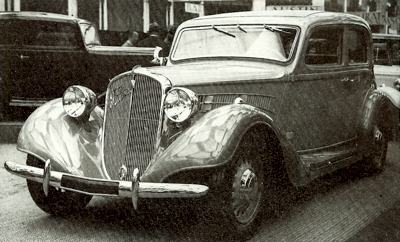 The first Simca cars were built under licence from Fiat, such as the 1935 Simca F11 based on the Balilla.
The first Simca cars were built under licence from Fiat, such as the 1935 Simca F11 based on the Balilla.
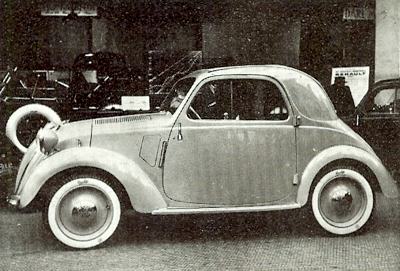 Another Fiat built under licence, the Simca Cinq based on the Fiat 500 Topolino.
Another Fiat built under licence, the Simca Cinq based on the Fiat 500 Topolino.
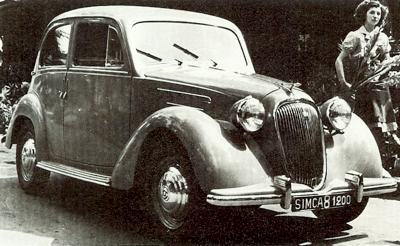 1949 Simca Huit, available in six different versions but all used the same 1200cc engine.
1949 Simca Huit, available in six different versions but all used the same 1200cc engine.
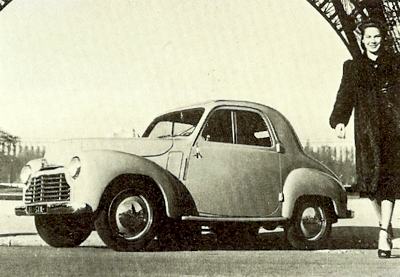 1949 Simca Six, based on the Topolino theme.
1949 Simca Six, based on the Topolino theme.
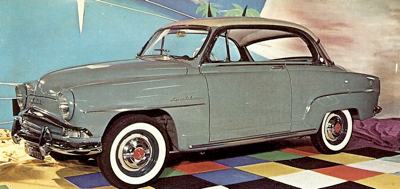 1957 Simca Grand Large 2-door version of the Aronde. It was powered by a 1221cc engine.
1957 Simca Grand Large 2-door version of the Aronde. It was powered by a 1221cc engine.
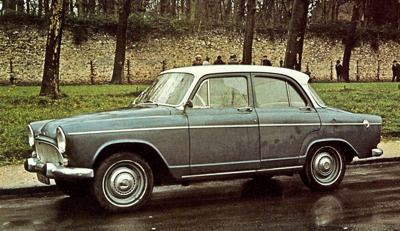 1962 Simca Aronde Elisee.
1962 Simca Aronde Elisee.
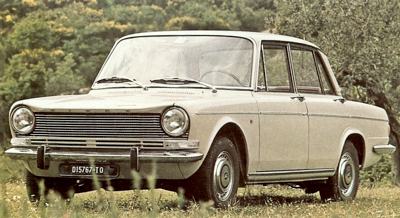 1970 Simca 1301. The same car was also available as a 1501 and Wagon.
1970 Simca 1301. The same car was also available as a 1501 and Wagon.
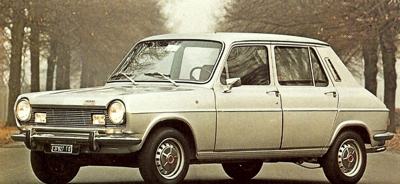 1970 Simca 1301 1294cc. It was a special version, and probably should have had a name change to signify the larger engine.
1970 Simca 1301 1294cc. It was a special version, and probably should have had a name change to signify the larger engine.
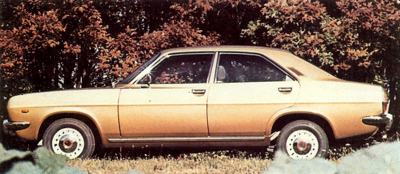 Chrysler 180, built by Simca and powered by a 1812cc engine.
Chrysler 180, built by Simca and powered by a 1812cc engine.
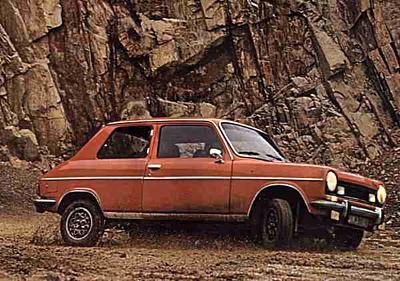 |
The Coupe des Petites Cylindrees
Gordini resumed his development and racing work with Simca after the end of the war and continued to breed race winning machines until 1951 when he came out from underneath the Simca umbrella and set up as a manufacturer of high performance cars in his own right. In 1947 Gordini had developed for Simca a 1100cc single seater sports car which had a number of successes on circuits including first, second and third places in the Coupe des Petites Cylindrees at Rheims. The following year saw the cars with five bearing crankshafts and a victory in the Bol d'Or and a class win in the 1948 Belgian 24 Hour Race.
Gordini's later efforts for Simca saw the cars equipped with 1
½ liter power units and their victories culminated in Trintignant's victory in the Albi Grand Prix in 1951. 1949 had seen the introduction of a Sport Cabriolet version of the Huit and 1950 the introduction of a Sports Coupe version. In 1949 a Cabriolet Sport type won its class in the Alpine Rally, while the following year two standard Huits took a brace of class wins in that year's Monte Carlo Rally.
The Simca 9
The following Spring a new model was shown in secret to the Simca management - the Simca 9. Although the 45 hp engine which powered it was a modified form of the engine which had powered the Huit, the rest of the car was entirely new and incorporated coil and wishbone independent suspension at the front and hypoid final drive. Much discussion followed the presentation of the car to the Simca board as to a suitable name for their new creation, and, eventually, they decided on the name 'L' Aronde'. This name was chosen because the symbol of the Simca marque was the swallow and the ancient French word for swallow was L' Aronde.
The Simca Aronde
In June the model was launched to the public and production began in earnest in the October after the factory at Nanterre had been extensively modernised .and new mass production machinery installed. With production of the Six terminating at the end of the previous year, Simca turned their efforts towards producing nearly 30,000 L' Arondes in the short time left to them in 1951 to add to the 20,568 units of the only other model they were still producing, the Huit. From the moment of its launch the Aronde was a startling success and at the end of 1952, when production of the Huit had been phased down to a mere 27 before ending completely, production of the Aronde had reached a staggering 69,028 units.
In 1953 and 1954 the Aronde was the only car which Simca were building, with production rising from 61,567 units in 1953 to 92,432 units in 1954 by which time there were six versions of the Aronde available including a Coupe de Ville model which had a 5 km per hour faster top speed than the standard 1,221 cc version. In 1954 the Aronde was put on the British market at a list price of £896. In 1953 an Aronde achieved the startling performance of completing 100,000 kilometres at a constant speed of 100 km/hr. Production of the Aronde continued until 1964 when only 21 units were built, with the 500,000th Aronde being delivered in January 1957 and the 1,000,000th in February 1960.
The Simca Vedette
In 1955 the Aronde had been the first Simca car to take their production in a year over 100,000 mark. Altogether Simca manufactured just under 1
½ million Arondes in its twelve year production history. In the meantime Simca had bought Unic in 1951, a company which had been founded in 1904 to build private cars but which ceased production with the outbreak of World War 2, and Ford's subsidiary in France in 1954, giving them what is still their largest manufacturing plant at Poissy, Seine-et-Oise and the rights to manufacture the Ford Vedette.
The Vedette had been introduced by Ford after World War 2 and was a fastback powered by a 2.2-liter 63 bhp V8 first introduced in 1936. Ford had also introduced, prior to the takeover, a Comete version with a sports coupe type of body. The 1953 models had 'notch' backs and the 1954 models a 3.9 liter V8 power unit and when Simca took over the 1955 models were given an 80 bhp version of the 2.2-liter V8 which continued in production as Simca Vedettes.
The Simca Ariane 4
Gradually the Poissy factory began to take over production of all Simca models which in 1955 consisted of versions of the Aronde and the Vedette, with the company producing 115,646 Arondes and 42,349 Vedettes that year. The Nanterre works were eventually turned over to Citroen in 1961. In 1956 Simca also bought the French subsidiary of Saurer, a company which had been established in Switzerland in 1897 to build motor cars but which had turned to the development of diesel engines and trucks in the first year of World War 1. In the following year Simca introduced the Ariane 4, a development of the Aronde and powered by the same 1290 cc power unit, but with the bodywork of the V8 Vedette Berlines.
In 1959 Simca bought their last company, Talbot, a company financed by Englishmen but producing in a factory in Suresnes. With an enviable list of competition successes behind them prior to the Simca takeover, the Suresnes factory continued to compete in races with the Ford V8 engine. Although a coupe. Talbot appeared at the Paris Salon in 1960 powered by a Simca Aronde engine - unfortunately the car did not go into production and the Talbot name was soon dropped altogther. A year earlier, in 1958, Simca themselves sold 15 per cent of their shares to the Chrysler Corporation of America and took the first step towards their eventual complete takeover.
The Chrysler Takeover
Chrysler achieving their share in Simca by purchasing the shares which had been attributed to the Ford Motor Company when the Simca-Ford SAF merger took place. At the same time Chrysler announced that their Australian factory in Adelaide would build Arondes under licence for the Australian market. Again in the same year the Simca Vedette was given a 84 bhp 2351cc power unit and so was the Ariane. Production of the Vedette continued until 1961 when units built totalled 166,895 though at least two versions were being built under licence in Brazil until 1967.
Development work had also been continuing throughout the financial negotiations on the Aronde range with a 1090cc 6CV model being introduced in 1959 together with a 1290cc 7CV version and the 1290cc P60 versions. Models of the Aronde continued in production until 1964, as did models of the Ariane of which 159,418 units had been built by the end of its production life. In 1960 the first Societe Simca was split into two companies: Simca Automobiles and Simca Industries, with Simca Automobiles receiving from the old Simca company all assets and facilities regarding the production of passenger cars and in particular the Poissy manufacturing plants.
The Simca 1000
Two years later Simca Automobiles produced their first new car under the new structure, the
Simca 1000. A 944cc rear engined saloon, the 1000 had a five bearing crankshaft, all round independent suspension, a four speed all synchromesh gearbox and had the radiator mounted alongside the engine. Production had begun at the end of 1961 with an initial stock of 9,670, but by the end of 1962 Simca had produced a further 154,282 and by the end of 1973 the company had constructed a total of 1,417,825 units. When the car first went on sale in France it was cheaper than Citroen's Ami 6. The saloon was quickly joined by a Bertone styled coupe using the same power unit and technical specification.
In 1963 the Simca 900 was added to the range which was also powered by the 944cc unit, and this model was joined by a 1300 version powered by a 1290cc unit and a 1500 version powered by a 1475cc engine. The following year a 'brake' version was added to the range. It was also in 1963 that the Chrysler Corporation increased their interest in Simca to a majority share holding of 64 per cent and in which M. Georges Hereil was named President-Director General of Simca. The following year Henri-Theodore Piggozi quietly passed away. Also in 1964 work began on a new production plant for Simca cars at La Rochelle and operations began there in 1965.
Societe des Automobiles Simca
Through the late 1960's and early 1970's the plant produced front and rear suspension, components for engines and gear boxes as well as shock absorbers. At the end of 1965 Simca Automobiles handed over all their assets to a new company, called Societe des Automobiles Simca. Later on, Simca Industries contributed to Societe des Automobiles Simca the shares they held in Societe de Metallurgie Automobile and in this way the basic products plant came back under the control of Simca Automobiles. The Simca 900 ceased production in the same year.
In 1966 the Simca 1000 became available with the option of a Ferodo three speed semi-automatic gearbox and the 1500 with a Borg Warner fully automatic box, and the Simca 1OOO van was introduced. The Chrysler Corporation increased their share in Simca to 77 per cent in 1967. That year also saw the introduction of uprated versions of the 1300 and 1500 to become the 1301 and 1501 and the addition of the Simca 1200S coupe which was powered by a 1204cc engine. A year later Simca introduced their transverse engined, front wheel drive 1100. Powered by a 1118cc engine, the car was available in two and four-door versions and various standards of trim, in addition to two 'brake' versions.
The Simca 4CV
Production of the 1100 passed the one million mark in 1973. 1969 saw the introduction of the austerity Simca 4CV which was powered by a 777cc engine which gave the car a top speed of 121 km/hr ; of the 1000 Special with an 1118cc unit; of the 1100 5CV with 944cc unit of the Simca 1000; and of the 1501 Special using the same 1475cc engine as before but with greater performance. The same year Simca took Matra Sports into the fold, the company which had been founded by Engin Matra to run Renault engined sports cars inherited from the defunct Rene Bonnet concern and updated Cosworth-Ford engined Formula Three racing cars.
Chrysler France
That year Simca's car production amounted to 351,103 units compared with 206,751 in 1958, an increase of 69 per cent in eleven years. By now Chrysler had increased its share holding in Simca to 99.3 per cent, so in July 1970 it changed the name of the company to Chrysler France, Simca had embarked on one of the biggest investment programmes in their history. At Poissy extensions were made to the pressing machine plant and the assembly lines as well as to the electroplating, paint and trim workshops; at Vernon a new commercial vehicle spare parts depot was built; at Carrieres-sous-Poissy a new research centre was built to supplant the previous one at Argenteuil and a complete modernisation programme was carried out at the company's Mortefontaine proving ground.
Gwain H. Gillespie
In addition the La Rochelle plant was doubled in size and the decision was taken to start work on a new assembly plant at Valenciennes. All Simca cars after 1967 carried the Chrysler Pentastar symbol but in September 1970, the first Chrysler named model, the 160, was launched. Originally designed by Rootes, the Chrysler company decided to export the design and the jigs to France and then re-import the 160 into Britain. Three versions were available, one powered by a 1639cc engine and the other two by a 1.8 liter engine. In September 1971 M. Gwain H. Gillespie was appointed President-Director General of Chrysler France. The following year saw the introduction of the Simca 1000 Rallye 1 with a 1294cc engine and of Simca 1000 and 1100 Specials.
The Simca Racing Team
1972 was also the year that the Simca Racing Team was formed and in June that year a Matra-Simca was driven to victory at Le Mans by Graham Hill and Henri Pescarolo-a feat which was repeated again in 1973 with Pescarolo again at the wheel but with Larrousse as eo-driver. In the September of 1972 the Simca Rallye 2 was introduced. In December the total production figures for a year long period passed the 500,000 mark for the first time in Simca history. Early in 1973 G. H. Gillespie was succeeded by Franklin M. Rogers as President-Director General and a month later, in the February, the Chrysler 2-liter automatic was introduced. This was joined the following month by the three seater, two door
Matra Simca Bagheera which was powered by a 1294cc transverse mid-engine.
The same year the new factory at Valenciennes went into production, and the number of Simca 1100s built passed the one million mark. In the December it was announced that Matra-Simca had won the Manufacturer's World Championship, and Simca's total car production since its formation reached six million. At the end of 1973 Chrysler France were producing six versions of the Simca 1000; eight versions of the Simca 1100; two versions of the 1301 and two of the 1501, together with the Chrysler 160, 180 and 2-liter. This range carried on into the energy crisis year of 1975. Since the introduction of the Simca 1307/1308 in mid-1975 merely cosmetic changes have been made to the range. The growing popularity of the Matra-Simca Bagheera, however, helped to give Simca a much needed more modern image.
Unfortunately, however, Chrysler's forced marriage of Simca and Rootes was not a happy one, and Chrysler Europe collapsed in 1977 and the remains were sold to Peugeot the following year. The Rootes models were quickly killed off, and the Simca-based Alpine/1307 and Horizon soldiered on through the first half of the 1980s using the resurrected Talbot badge. The last car to carry the Simca badge was the 1980 Solara, a 1307 with a boot, but by 1981 this had become a Talbot, thus axing the Simca marque entirely.
